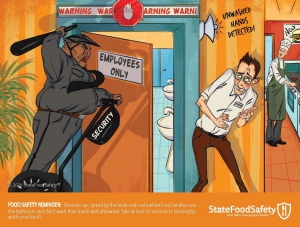Food Handler Information
Food Handlers Certification (Food Card)
Food Handler Certifications, aslo know as food cards, are required by the Mingo County Health Department. To obtain a food handler’s certification/card, there are normally mulitiple options available. Anyone working with food prep, serving, or cooking is required to have a food handler card. Food handler cards are good for one year only from the date issued when received from either our online class or at a local food handler's class.
Mingo County Food Handler's Card
Any food handler worker my obtain their food card either by attending an online training class authorized by the Mingo County Health Department or by attending on of our local training classes. Please click on the link below to go to our Food Handler's Class page for more details about getting into a Food Handler's Training Class.
You may be ready for the online Food Handler's Training class now, if so, just click on the pic or link below:

CLICK HERE for both Food Handler’s Class and the New Food Manager’s Certification.
Food Hander's Information and Resources
“Don’t go to that restaurant. I got food poisoning a few weeks ago from there.”
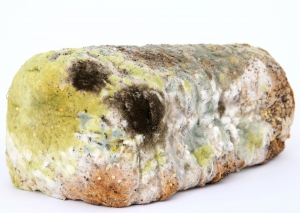 If this sounds familiar, you are not alone. Each year, foodborne illness affects about 48 million Americans. If your establishment is not focused on making food safety a priority, you could potentially have a food-borne illness outbreak, endangering your customers and harming your business.
If this sounds familiar, you are not alone. Each year, foodborne illness affects about 48 million Americans. If your establishment is not focused on making food safety a priority, you could potentially have a food-borne illness outbreak, endangering your customers and harming your business.
Help keep consumers happy and healthy by recognizing the important role food safety plays and implementing safe practices. Here are three practices that, if used, will foster a food safety culture and decrease the risk of customers contracting a food-borne illness.
Use Disposable Gloves Correctly
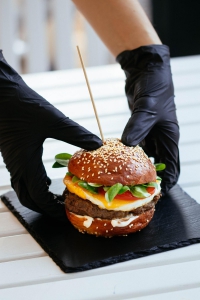 Gloves play an essential part in food safety. By creating a barrier between your hand and the food you are preparing, clean gloves can prevent the spread of food-borne illnesses. If used incorrectly, they can spread pathogens and other contaminants to the food that could cause illness or disease.
Gloves play an essential part in food safety. By creating a barrier between your hand and the food you are preparing, clean gloves can prevent the spread of food-borne illnesses. If used incorrectly, they can spread pathogens and other contaminants to the food that could cause illness or disease.
Gloves should be changed after switching tasks, after four continuous hours of use, if they are dirty or torn, or after touching your hair or face. In addition, if you think your gloves might have been contaminated, you should change them. As the old saying goes, when in doubt, throw it out. Hands should always be washed prior to putting gloves on. Failure to do so could result in contamination of the gloves.
Wash Your Hands
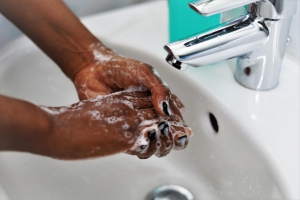 Proper hand washing can prevent the spread of pathogens. Other food safety techniques won’t be nearly as effective if they are not combined with good hand washing. Good hand washing begins by scrubbing your hands, under your fingernails, and your lower arms with soap. Dry your hands with a paper towel while avoiding touching the dispenser.
Proper hand washing can prevent the spread of pathogens. Other food safety techniques won’t be nearly as effective if they are not combined with good hand washing. Good hand washing begins by scrubbing your hands, under your fingernails, and your lower arms with soap. Dry your hands with a paper towel while avoiding touching the dispenser.
Hands must be washed when switching tasks, and twice after using the restroom. Hands should also be washed if an employee touches their hair or face. New disposable gloves should be put on after washing hands.
Don't let Handwashing Security catch YOU!
Remember to Clean and Sanitize
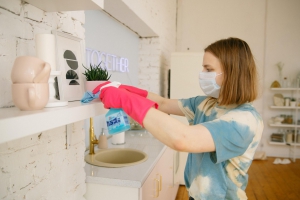 Using clean and sanitized tools, surfaces, and utensils prevents the spread of harmful bacteria. Cleaning includes using soap and water to remove food, dirt, and pathogens. Sanitizing follows cleaning, killing the bacteria on the clean equipment. It’s important to start with a clean prep station, but equally as important to clean and sanitize after four continuous hours. Four hours is the amount of time that bacteria will grow to harmful levels.
Using clean and sanitized tools, surfaces, and utensils prevents the spread of harmful bacteria. Cleaning includes using soap and water to remove food, dirt, and pathogens. Sanitizing follows cleaning, killing the bacteria on the clean equipment. It’s important to start with a clean prep station, but equally as important to clean and sanitize after four continuous hours. Four hours is the amount of time that bacteria will grow to harmful levels.
Equipment and surfaces should also be cleaned if there is risk of cross-contamination. Cross contamination occurs when pathogens are unknowingly transferred from one surface or piece of equipment to another or food, which can be potentially harmful. Be sure to clean and sanitize cutting boards after handling raw meat, poultry, fish, or seafood. Wash all fruits and vegetables before placing them on surfaces that will not be cleaned or sanitized before use.
Food safety plays an important role in the reputation of an establishment. Implementing good, safe practices will ensure you are doing all you can to avoid a food-borne illness outbreak. Never give up on food safety; it’s an investment you can’t afford to not make.


 Download our free app today to receive real-time alerts, catch up on news, view upcoming events and track important dates.
Download our free app today to receive real-time alerts, catch up on news, view upcoming events and track important dates.